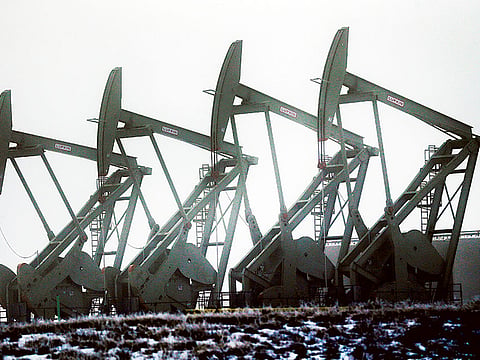Just when the rout seemed almost over, drillers idle 42 oil rigs
WTI down 52% from the 52- week high of $107.73 reached on June 20 last year

San Francisco: Just when you thought the US oil-drilling retreat was slowing, explorers dropped 42 rigs in a single week.
Those actively drilling for oil slid to 760 this week, the lowest since December 2010, the Houston-based field services company Baker Hughes Inc. said on its website Friday. The slide followed two weeks of modest declines that appeared to show the pace of an unprecedented retrenchment in drilling was easing. Producers instead pulled 20 rigs this week out of the Permian Basin of New Mexico and Texas alone.
Traders are watching the weekly counts as they wait for US production to drop and rebalance oil markets. The country has lost more than half its oil rigs since October as a more than $50-a-barrel collapse in crude prices prompts drillers to scale back spending in shale formations.
“There is going to have to be a fundamental change in the market before the rig count stops dropping,” Trisha Curtis, director of upstream research at the non-profit Energy Policy Research Foundation Inc., said by phone from Washington. “Rigs and oil production are one step removed, so unless something fundamental in production changes oil prices, a lot of these companies just don’t have the money to continue the activity they were doing.”
The US benchmark West Texas Intermediate oil for May delivery rose 85 cents on Friday to settle at $51.64 a barrel on the New York Mercantile Exchange, down 52 per cent from the 52- week high of $107.73 reached June 20.
Production Peak
The steep decline in the rig count this week “a little bit surprising,” James Williams, president of energy consultant WTRG Economics, said by phone on Friday. “What is clear is that US oil production will, if it hasn’t already, peak by next month, and by the second half of this year, we will be seeing measurable declines.”
Evercore ISI analysts including James West said in a research note on Thursday that the “impending supply drop” will coincide with increased US refinery runs heading into the peak summer driving season and work to correct “the global supply-demand imbalance.”
The slowdown in drilling has yet to make a real dent in US oil production, which reached a weekly record in March because of bigger and higher-yielding shale wells. Output climbed 18,000 barrels a day last week to 9.4 million, Energy Information Administration data show.
“It takes a while for the production to moderate,” Janelle Nelson, a Minneapolis-based portfolio analyst with RBC Wealth Management’s portfolio advisory group, said by phone on April 8. “There may be fewer rigs drilling, but they’re drilling the best wells with the best productivity with the best operators.”
Rebalance Starting
While Goldman Sachs Group Inc. said in an April 6 research note that US production is showing signs of nearing a peak, crude stockpiles have continued to swell. Domestic oil supplies rose by another 10.9 million barrels to a record 482.4 million in the week ended April 3, EIA data show.
Contributing to the worldwide glut of oil is output from the Organisation of Petroleum Exporting Countries, which accounts for about 40 per cent of the world’s oil and has resisted calls to curb production. Opec will increase crude exports by 200,000 barrels a day this month, according to tanker tracker Oil Movements.
“People home in on a certain thing like the rig count in the US, and they forget that it’s not just about Americans,” Curtis said. “Even if we took off a couple of hundred thousand barrels a day of production, it would have to be a sustained level and there would have to be some momentum around the rest of the world.”
Crude prices will need to remain low in the coming months to achieve a decline in US production that’s steep enough to rebalance global oil markets, Goldman said in its report. “While the decline in the US rig count has been faster than we expected,” the bank said, “it remains insufficient.”
Sign up for the Daily Briefing
Get the latest news and updates straight to your inbox



